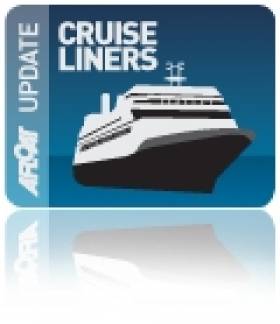Displaying items by tag: P&O giant cruiseship
Cruiseships Large & Small Visit Competing Dublin Bay Ports on Day of Casting of the Spear
#CruiseDublinBay – Two cruiseships one large the other small, yesterday visited separately Dublin Port and Dun Laoghaire Harbour, the later destination welcoming its first caller this year, writes Jehan Ashmore.
Princess Cruises 3,082 passenger capacity Emerald Princess (2007/118,681grt) docked in Dublin, having sailed from Cork overnight while Island Sky (1992/4,200grt) called to Dun Loaghaire after also picked up a pilot in the bay having sailed from Waterford city-centre.
The Noble Caledonia operated Island Sky is on a 'Gardening' themed cruise with 87 passengers out of a 114 total capacity, making visits of spectacular gardens in bloom and earlier today she docked in Holyhead.
Meanwhile, Emerald Princess is heading through the English Channel this evening in the busy shipping lane off Alderney and understood to be bound for Zeebrugge, Belgium.
Emerald Princess call to Dublin Port involved her berth at Ocean Pier west, which is close to the proposed €30m cruise terminal that forms part of the €200m Alexandra Basin Redevelopment (ABR) Project. This year the port is scheduled for around 90 callers.
Further upriver along Sir John Rogerson Quay, St. Bridget of Dublin Bay Cruises was moored at her berth opposite the Convention Centre. The landmark is an easy reference point to where passengers board and disembark on excursions to Howth, Dun Laoghaire and from that harbour a late afternoon cruise is offered to Killiney Bay.
On the Liffey, the shipping scene yesterday notably focused on the sheer presence of Emerald Princess which could be seen in the distance downriver, even before St. Bridget set off on a special short cruise through the East-Link bridge and beyond to the port channel.
In a becalmed sea, Lord Mayor of Dublin, Oisin Quinn was kept busy having launched a new Dublin – Land & Sea ticket in conjunction with Dublin Bus Tours followed by a photocall for a Dublin based councillor as a candidate of the forthcoming European elections. Not to mention the honorary role of the mayor as Admiral of Dublin Port, where such duties were performed for the annual tradition of 'casting of the spear'.
The ceremonial tradition dates back to 1488 when Lord Mayor, Thomas Mayler, according to historical records set out on his horse to ride across the strand and to cast the spear and from wherever it landed marked the city's boundaries.
Looking across the present day strand of south Dublin Bay, is the structure of Dun Laoghaire Harbour with its fine piers jutting into the sea from where the Island Sky arrived into port, the first of four to call this season.
Among them is another newcomer, Seabourn Legend of the luxury Seabourn Cruises fleet of large private yacht-like ships. She is due to call in August.
Likewise of Dublin Port, the Dun Laoghaire Harbour Company, also propose a dedicated cruise terminal costing €17m, so to handle even larger vessels such as Emerald Princess, in which the capital port have also factored into in terms of their terminal design plans.























